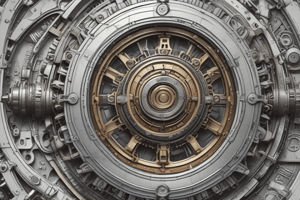Podcast
Questions and Answers
What is the diameter of the circle that represents the pitch circle of a gear called?
What is the diameter of the circle that represents the pitch circle of a gear called?
- Root Diameter
- Pitch Circle (correct)
- Addendum Circle
- Dedendum Circle
How is the clearance of a gear defined?
How is the clearance of a gear defined?
- The total depth of a tooth space
- The height of the tooth above the pitch circle
- The radial distance from the pitch circle to the root circle
- Distance between the outside diameter of a gear and the root diameter of its mate (correct)
What does the term 'whole depth' refer to in gear nomenclature?
What does the term 'whole depth' refer to in gear nomenclature?
- The depth of engagement of two gears
- The total depth of a tooth space equal to addendum plus dedendum (correct)
- The distance from the pitch circle to the root circle
- The maximum height of the tooth above the pitch circle
What does the pressure angle (θ) in gear systems represent?
What does the pressure angle (θ) in gear systems represent?
Which formula correctly represents the dedendum circle's diameter?
Which formula correctly represents the dedendum circle's diameter?
What does the addendum of a gear measure?
What does the addendum of a gear measure?
Which statement correctly defines the angle of action in gear engagement?
Which statement correctly defines the angle of action in gear engagement?
What is the involute in gear design?
What is the involute in gear design?
How does a large pressure angle affect gear performance?
How does a large pressure angle affect gear performance?
What does the arc of action refer to in the context of gears?
What does the arc of action refer to in the context of gears?
Flashcards are hidden until you start studying
Study Notes
External Spur Gear Nomenclature
- Pitch Circle (D) is the circle with a radius equal to the distance from the gear axis to the pitch point. This is the diameter of the cylinder that would replace the gear pair if they were rolling cylinders.
- Addendum (a) is the height of the tooth above the pitch circle. Essentially, it's the distance between the pitch circle and the tooth's top.
- Dedendum (d) is the radial distance from the pitch circle to the root circle (at the bottom of the tooth space). The formula for dedendum is: d = a + c
- Clearance (c) is the space between the outer diameter of one gear and the root diameter of its mating gear. This margin prevents tooth interference.
- Addendum Circle (Da) is the circle bounding the outer ends of the teeth. Its diameter is calculated as: Da = D + 2a
- Dedendum Circle (Dd) is the circle coinciding with or tangent to the bottoms of the tooth spaces. Its diameter is calculated as: Dd = D - 2d or Dd = D - 2(a + c)
- Root Diameter is the diameter of the dedendum circle.
- Base Circle (Db) is the circle used to construct the involute gear profile. Its diameter is calculated as: Db = D * cos θ, where θ is the pressure angle.
- Working Depth (WR) is the depth of engagement between two gears, calculated by summing their addenda: WR = 2a
- Whole Depth (WL) is the total depth of a tooth space. It's the sum of the addendum and the dedendum, or the working depth plus clearance.
- Pressure Angle (θ) is the angle between the line of action of the force on the tooth and the line tangent to the pitch circles. A larger pressure angle can lead to a larger radial pressure on the bearings.
- Line of Action is the straight line passing through the pitch point and tangent to the base circles. It coincides with the pressure angle line.
- Involute is the curve generated by a point on a straight line rolling against a circle. Most gears use an involute tooth profile.
- Module is the reciprocal of the diametral pitch.
- Angle of Approach is the angle a gear rotates from the moment two teeth first touch until they are in contact at the pitch point.
- Angle of Recess is the angle a gear rotates from the moment two teeth are in contact at the pitch point until they are no longer in contact.
- Angle of Action is the total angle a gear rotates from the point where two teeth first touch until they are no longer in contact. It's the sum of the angles of approach and recess.
- Arc of Approach is the arc subtended by the angle of approach.
- Arc of Recess is the arc subtended by the angle of recess.
- Arc of Action is the arc of the pitch circle traversed by a tooth from the first point of contact to the point where contact ends.
Standard Gear Tooth Proportions
- System refers to the design standard used for gear teeth. Different systems have different tooth proportions (e.g., 14 1/2°, 20°, etc.)
- Addendum is the height of the tooth above the pitch circle. Different systems have different addendum values.
- Dedendum is the radial distance from the pitch circle to the root circle. It varies across different systems.
- Clearance is the space between the outer diameter of the gear and the root diameter of its mate.
- Working Depth is the depth of engagement between two gears.
- Total Depth is the total depth of the tooth space.
- Outside Diameter is the diameter of the gear's outer circle.
- Tooth Thickness is the measurement of a tooth along the pitch circle.
- Tooth Space is the space between two adjacent teeth along the pitch circle.
- Fillet Radius is the radius of the curved transition at the base of the tooth.
Law Governing the Shape of Teeth
- The profile design of gear teeth must adhere to the fundamental law: The line connecting the pitch point and the contact point between two teeth must be perpendicular to the line tangent to the tooth curves at the point of contact. This ensures smooth and constant transmission of power.
The Involute of a Circle
- The involute is a curve generated by a point on a line rolling against a circle.
- This curve is used to create the shape of gear teeth.
- The involute curve is created by constructing perpendicular lines to the radius at equal intervals around the base circle.
Example Problems
- Example 1: This example demonstrates calculating the center distance between two gears, given the number of teeth on each gear and the diametral pitch. The formula used is: Center distance = (D1 + D2)/2, where D1 and D2 are the pitch diameters of the gears.
- Example 2: This example demonstrates calculating the speed of a driving gear, given the speed of the driven gear, center distance, and number of teeth on the driving gear. The fundamental formula used is: N1 * D1 = N2 * D2, where N1 and N2 are the speeds of the gears, and D1 and D2 are the pitch diameters.
- Example 3: This example demonstrates calculating circular pitch, center distance, and base circle radii for a gearset, given the number of teeth, diametral pitch, addendum, dedendum, and pressure angle. The formula used to calculate the circular pitch is: PC = π/PD, where PD is the diametral pitch. The formulas used for center distance and base circle radii are explained in the nomenclature section above.
Studying That Suits You
Use AI to generate personalized quizzes and flashcards to suit your learning preferences.




